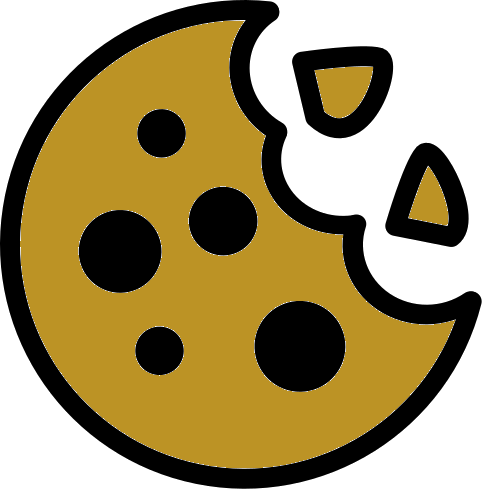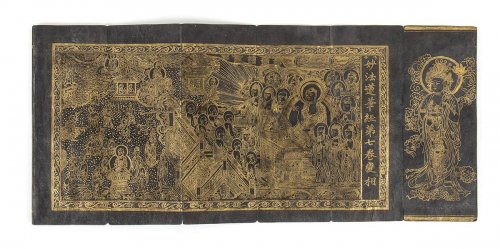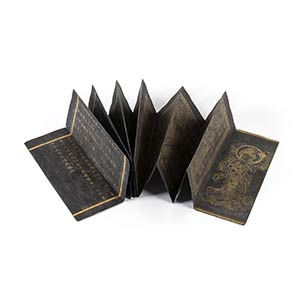
- Home
- Online auctions
-
Ended auctions
- Coins & Medals
- Philately
- Antiquities
- Old Masters
- Jewellery, Silver, Watches
- Ancient and Modern Glyptic
- Ceramics
- Antiques
- Modern & Contemporary Art
- 20th Century Design and Decorative Arts
- Prints and Multiples
- Asian and Tribal Art
- Photography
- Medieval Art
- Ancient Frames
- Fashion, Textiles & Luxury
- Books, Autographs and Memorabilia
- Wines and spirits
- Oddities, Curiosities & Wonders
- Info
- Live Auction
- Home
- Auction 93
- 152 A BUDDHIST MANUSCRIPT WITH THE SEVENTH CHAPTER OF THE LOTUS ...
Lot 152 - Auction 93
Description
A BUDDHIST MANUSCRIPT WITH THE SEVENTH CHAPTER OF THE LOTUS SUTRA
Korea, Goryeo dynasty style
The folding manuscript consists of sixteen sheets (each 24,9 x 9,9 cm) with an indigo background. While the back shows no decoration - with the exception of the two sheets that act as frontispiece and final, both decorated with a floral arabesque, the first with a rectangular cartouche with the title of the text -, the recto is finely highlighted with gold. The two pages at the ends both present two standing bodhisattva. On the right, on five sheets - introduced again by the title - a scene set on a terrace with the Buddha surrounded by deities; in the adjacent space other divinities and figures in different attitudes, between architectures arranged near a stream of water. The text with the characters arranged in vertical rows.
24,9 x 158,4 cm
Provenance: private collection.
The Lotus Sutra (sanskrit: Saddharma Puṇḍarīka Sūtra; chinese: 妙法 蓮華 經, Miaofa Lianhua jing; korean: 묘법 연화경, Myobeop Yeonhwa gyeong) is the most popular sutra of the Mahayana Buddhism, widespread throughout Asia and recited by a multitude of faithful in order to achieve salvation.
The Lotus Sutra consists of twenty-eight paragraphs. The seventh, transcribed in the manuscript discussed here, reports the 'Parable of the Ghost Town', in which it tells of a group of people in search of a great treasure, a story to which the illuminated image in this manuscript also refers. Tired of the journey through the desert, the pilgrims are about to give up when their wise guide creates a ghost town so that they can rest and thus resume their journey. The parable therefore urges to consider the city - the nirvana of the holy arhats - as an illusory and temporary well-being, as opposed to the treasure - the Enlightenment - which is lasting although more demanding to achieve.
The production of Buddhist manuscripts (sagyong) is one of the most admired forms of art in Korea, appreciated since ancient times also in China, Japan and Mongolia, countries in which numerous examples of these illustrated texts are still preserved.
During the Goryeo period (918-1392), this devotional practice reached its artistic peak, with the production of numerous examples made for many patrons. To meet the great demand, the Royal Office for Sutras (Sagyongwon) was therefore established in the twelfth century, in which monks and professional calligraphers dedicated themselves to the production of manuscripts similar to the one presented here.
Usually, the manuscripts were made using a very precious paper obtained from the inner bark of the mulberry tree, then dyed in indigo, a background against which the calligraphic text and images (pyonsang) in gold or silver stood out. The opening and closing of the manuscript are usually decorated with arabesques of the flowers called posang tangcho.
The Metropolitan Museum in New York owns a similar manuscript with the Lotus Sutra (volume II), dated around 1340 (inv. 1994.207).
Please use the registration form to send us your participation request, or, if you are already registered and authorized, use the login box on the top.
For any information please contact info@bertolamifineart.com
Categories
Auction: Auction 93
- China - Ceramics and porcelain
- China - Metals
- China - Varia
- China - Jade and hardstones
- China - Cloisonnè
- China - Sculpture
- China - Ivory
- China - Painting
- China - carpets and Textile
- China - Furniture
- Himalayan area
- Korea
- Japan - Ceramic and porcelain
- Japan - Metal
- Japan - Lacquer
- Japan - Sculpture
- Japan
- Japan - Ivory
- Japan - Varia
- Islam
- India
- South East Asia
- Africa, Coptic manuscripts
- Africa
- America
 Respecting your privacy is our priority
Respecting your privacy is our priority
This site uses cookies to improve user experience and to collect information on the use of the site. There are also cookies that can be used for the selection of personalized advertisements and promotional content. You can read our cookie policy, accept all cookies and continue browsing by clicking on "Accept" or customize your choice by clicking on "Customize".
Cookie Policy
Cookies
To make this site work properly, we sometimes install small data files called "cookies " on your device. Most of the big sites do the same.
What are cookies?
A cookie is a small text file that websites save on your computer or mobile device while you visit them. Thanks to cookies, the site remembers your actions and preferences (for example login, language, font size and other display settings) so that you do not have to re-enter them when you return to the site or browse from one page to another.
How do we use cookies?
Third party cookies
Google Analytics
This site uses Google Analytics to collect information about the use of users of its website. Google Analytics generates statistical and other information through cookies, stored on users' computers. The information generated relating to our website is used to make reports on the use of websites. Googl
How to control and modify cookies?
You can modify or withdraw your consent at any time from the cookie declaration on our website.
Privacy Policy
Find out more about who we are, how you can contact us and how we process personal data in our privacy policy .
The necessary cookies help to make the website usable by enabling basic functions such as page navigation and access to protected areas of the site. The website cannot function properly without these cookies.
| Name | Supplier | Purpose | Expiry |
|---|---|---|---|
| cookieConsent | Bid Inside | Stores the user's cookie consent status for the current domain | 6 months |
| PHPSESSID | Bid Inside | Preserve the user's status in the different pages of the site. | When the browsing session ends |
| f_display | Bid Inside | The f_display cookies memorize the display mode chosen by the user in the pages where there are lists | When the browsing session ends |
| f_page | Bid Inside | The f_page cookies store the page viewed by the user in the pages where there are lists | When the browsing session ends |
| f_rec_page | Bid Inside | The f_rec_page cookies store the number of elements to be displayed per page chosen by the user in the pages in which there are lists | When the browsing session ends |
| f_order_by | Bid Inside | The f_order_by cookies store the sorting parameter selected by the user in the pages where there are lists | When the browsing session ends |
| f_order_dir | Bid Inside | The f_order_dir cookies store the ordering direction chosen by the user in the pages where there are lists | When the browsing session ends |
| watch_list_show_imgs | Bid Inside | The watch_list_show_imgs cookie stores the user's choice to show or hide lot images on the watch list page | When the browsing session ends |
| selected_voice | Bid Inside | The selected_voice cookie stores the voice selected by the user for the speech synthesis present in the live auction | 1 Month |
| include_autobids | Bid Inside | The include_autobids cookie stores the user's choice to show or hide their auto-bids on the 'Your bids' page | 6 months |
Analytical cookies help to understand how visitors interact with the website, collecting and transmitting statistical information to the Data Controller.
| Name | Supplier | Purpose | Expiry |
|---|---|---|---|
| _ga | Register a unique ID used to generate statistical data on how the visitor uses the website. | 2 years | |
| _gat_gtag | Used by Google Analytics to limit the frequency of requests | 1 day | |
| _gat | Used by Google Analytics to limit the frequency of requests | 1 day | |
| _gid | Register a unique ID used to generate statistical data on how the visitor uses the website. | 1 day | |
| __utma | Bid Inside | Used to distinguish users and sessions. The cookie is created when the javascript library executes and no existing __utma cookies exists. The cookie is updated every time data is sent to Google Analytics. | 2 years |
| __utmt | Bid Inside | Used to throttle request rate. | 10 minutes |
| __utmb | Bid Inside | Used to determine new sessions/visits. The cookie is created when the javascript library executes and no existing __utmb cookies exists. The cookie is updated every time data is sent to Google Analytics. | 30 minutes |
| __utmc | Bid Inside | Not used in ga.js. Set for interoperability with urchin.js. Historically, this cookie operated in conjunction with the __utmb cookie to determine whether the user was in a new session/visit. | When the browsing session ends |
| __utmz | Bid Inside | Stores the traffic source or campaign that explains how the user reached your site. The cookie is created when the javascript library executes and is updated every time data is sent to Google Analytics. | 6 months |
| __utmv | Bid Inside | Used to store visitor-level custom variable data. This cookie is created when a developer uses the _setCustomVar method with a visitor level custom variable. This cookie was also used for the deprecated _setVar method. The cookie is updated every time data is sent to Google Analytics. | 2 years |
Preference technical cookies allow a website to remember information that affects the way the site behaves or presents itself, such as your preferred language or the region you are in.
We do not use cookies of this type.Profiling cookies are used for marketing purposes, to monitor website visitors. The intent is to display relevant and engaging ads for the individual user.
| Name | Supplier | Purpose | Expiry |
|---|---|---|---|
| _fbp | Facebook Pixel, targeting and advertising cookie. This cookie allows us to show our advertising to people who have already visited our website, when they are on Facebook or on a digital platform supported by Facebook Advertising. | 6 months | |
Unclassified cookies are cookies that are being classified, together with individual cookie providers.
We do not use cookies of this type.






 153
153